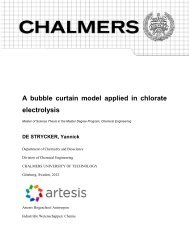A computational grammar and lexicon for Maltese
A computational grammar and lexicon for Maltese
A computational grammar and lexicon for Maltese
You also want an ePaper? Increase the reach of your titles
YUMPU automatically turns print PDFs into web optimized ePapers that Google loves.
Head- driven Phrase Structure Grammar (HPSG) (Pollard & Sag, 1994) is a highly lexicalised<br />
generative <strong>grammar</strong> theory, where the <strong>lexicon</strong> has a richly structured hierarchy of types.<br />
In most applications, HPSG <strong>grammar</strong>s are used as st<strong>and</strong>-alone wide-coverage parsers. Sign-<br />
Based Construction Grammar (SBCG) (Sag et al. , 2012) is a more recent <strong>for</strong>malism based on<br />
HPSG. The LinGO Grammar Matrix (Bender et al. , 2002) is an HPSG-based framework <strong>for</strong><br />
the development of broad-coverage, precision, implemented <strong>grammar</strong>s <strong>for</strong> diverse languages.<br />
LingGO Matrix <strong>grammar</strong>s are available under open source licenses.<br />
CCGs, TAGs <strong>and</strong> Head Grammars have been shown to all be weakly equivalent to each<br />
other, in the sense that they all define the same string languages (Vijay-Shanker & Weir, 1994).<br />
Regulus (Rayner et al. , 2006) is a multilingual plat<strong>for</strong>m <strong>for</strong> compiling unification <strong>grammar</strong>s<br />
<strong>for</strong> speech-based applications. It provides open-source resource <strong>grammar</strong>s <strong>for</strong> a h<strong>and</strong>ful of<br />
languages.<br />
Functional morphology (FM) (Forsberg & Ranta, 2004) presents a method <strong>for</strong> implementing<br />
natural language morphology in Haskell, which has been applied to small number of languages.<br />
It can be thought of as a fragment of GF embedded in Haskell, yet some phenomena<br />
such as stem-internal vowel changes are easier to write in FM due to Haskell’s more powerful<br />
string <strong>and</strong> list processing functions.<br />
4.3.4 Rule-based translation<br />
Apertium 8 is an open-source system <strong>for</strong> rule-based machine translation (RBMT). Unlike GF,<br />
its rules are transfer-based <strong>and</strong> there is no language-independent representation of meaning.<br />
Partial implementations exist <strong>for</strong> translation from <strong>Maltese</strong> to Arabic 9 <strong>and</strong> Hebrew 10 , but these<br />
could not be used in any tangible way in the current work.<br />
GramTrans 11 is a cross-plat<strong>for</strong>m machine translation plat<strong>for</strong>m which is also transfer based.<br />
It offers free web-based translation <strong>for</strong> the Sc<strong>and</strong>inavian languages, but the source code is proprietary.<br />
4.4 Future work<br />
4.4.1 Grammar extensions<br />
• The primary task that this work leads to is of course increasing the coverage of the resource<br />
<strong>grammar</strong> to include the failed cases from the treebank tests, <strong>and</strong> the other limitations<br />
in the <strong>grammar</strong> noted in section 4.2.1. The treebanks accompanying the <strong>grammar</strong><br />
should also be extended accordingly.<br />
• The Extra abstract module distributed with GF is not a part of the RGL API but contains a<br />
number of constructions which languages can optionally implement. Many of these extra<br />
8 http://www.apertium.org/, accessed 2013-07-24<br />
9 http://source<strong>for</strong>ge.net/p/apertium/svn/46324/tree/staging/apertium-mt-ar/, accessed 2013-07-24<br />
10 http://source<strong>for</strong>ge.net/p/apertium/svn/46324/tree/staging/apertium-mt-he/, accessed 2013-07-24<br />
11 http://gramtrans.com/, accessed 2013-09-04<br />
64















